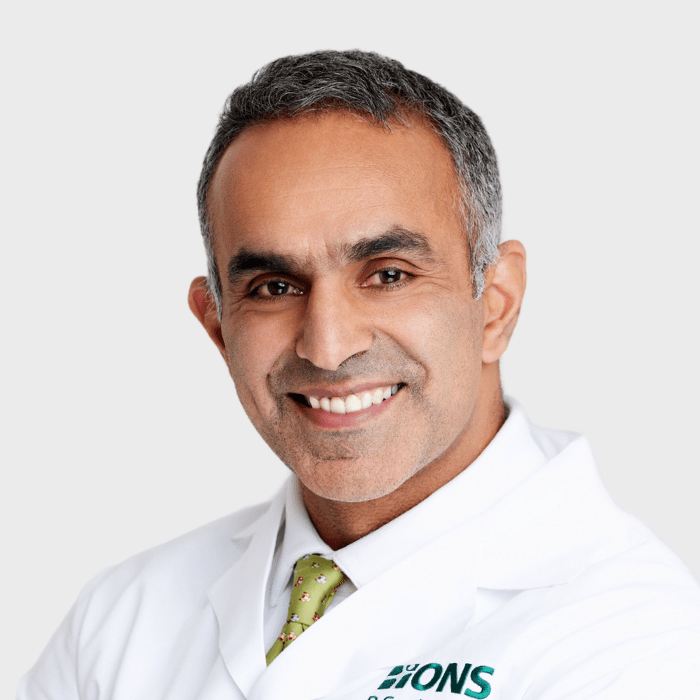Where It Hurts: My Elbow
Your elbow is full of muscles, nerves, and tendons that can become irritated and cause pain. Overuse and sports injuries are the two biggest culprits of elbow problems. But arthritis can also affect elbows. Learn more about elbow pain and how the hand and upper extremity surgeons and sports medicine specialists at Orthopaedic & Neurosurgery Specialists (ONS) can help.
Common Elbow Injuries and Conditions
We see patients with all types of elbow pain, and the most common injuries and conditions we treat are:
- Arthritis: Arthritis, which causes pain and swelling in your elbow joint, happens as cartilage breaks down. Arthritis is less common in the elbow than other joints but sometimes happens after an elbow fracture.
- Cubital tunnel syndrome: This often feels like numbness in the ring and little fingers, especially when holding your elbow bent for a while (like while holding a phone). It can also cause forearm pain and weakness in the hand.
- Elbow bursitis: Called olecranon bursitis, this is a swelling on the back of your elbow. It can happen from hitting your elbow, falling on your elbow, or repeatedly leaning your elbow on hard surfaces.
- Elbow fractures and dislocations: You can break, or fracture, your elbow in different places. You might hear a snap or pop, but it will almost definitely be painful and swollen.
- Elbow ligament injuries: You have ligaments on the inner and outer sides of your elbow. The ulnar collateral ligament (UCL) is the inner one, and tearing it is a common injury for baseball pitches. The surgery to repair it, Tommy John Surgery, is even named after a pitcher. The biceps tendon is the tendon on the front of the elbow, this can tear causing pain and the muscle can ball up.
- Golfer elbow: Known as medial epicondylitis, it’s like tennis elbow, but the pain is on the side of the elbow closest to your body. It can happen from the repeated stress of holding a golf club, racquet, or other object that requires grip.
- Tennis elbow: Called lateral epicondylitis, this affects the tendon that runs down the outside of your arm. The pain often starts on the outside of your elbow and runs down your forearm. Holding a racquet or other repetitive gripping activities can cause it.
We see patients with all types of elbow pain, and the most common injuries and conditions we treat are:
- Arthritis: Arthritis, which causes pain and swelling in your elbow joint, happens as cartilage breaks down. Arthritis is less common in the elbow than other joints but sometimes happens after an elbow fracture.
- Cubital tunnel syndrome: This often feels like numbness in the ring and little fingers, especially when holding your elbow bent for a while (like while holding a phone). It can also cause forearm pain and weakness in the hand.
- Elbow bursitis: Called olecranon bursitis, this is a swelling on the back of your elbow. It can happen from hitting your elbow, falling on your elbow, or repeatedly leaning your elbow on hard surfaces.
- Elbow fractures and dislocations: You can break, or fracture, your elbow in different places. You might hear a snap or pop, but it will almost definitely be painful and swollen.
- Elbow ligament injuries: You have ligaments on the inner and outer sides of your elbow. The ulnar collateral ligament (UCL) is the inner one, and tearing it is a common injury for baseball pitches. The surgery to repair it, Tommy John Surgery, is even named after a pitcher. The biceps tendon is the tendon on the front of the elbow, this can tear causing pain and the muscle can ball up.
- Golfer elbow: Known as medial epicondylitis, it’s like tennis elbow, but the pain is on the side of the elbow closest to your body. It can happen from the repeated stress of holding a golf club, racquet, or other object that requires grip.
- Tennis elbow: Called lateral epicondylitis, this affects the tendon that runs down the outside of your arm. The pain often starts on the outside of your elbow and runs down your forearm. Holding a racquet or other repetitive gripping activities can cause it.
Physicians

- Hand and Upper Extremity
Practicing in:
Greenwich, Stamford, and Wilton
- Hand and Upper Extremity
Practicing in:
Greenwich and Stamford
- Physiatry
- Spine
- Sports Medicine
Practicing in:
Greenwich, Stamford, and Wilton
- Sports Medicine
- Shoulder
Practicing in:
Greenwich and Stamford
- Sports Medicine
- Shoulder
Practicing in:
Greenwich, Stamford, and Wilton Director, ONS Sports Concussion Center
Director, ONS Sports Concussion Center- Primary Care Sports Medicine
- Sports Medicine
Practicing in:
Greenwich and Harrison
- Sports Medicine
- Shoulder
Practicing in:
Greenwich and Stamford
- Physiatry
- Spine
- Sports Medicine
Practicing in:
Greenwich Director of Ultrasound
Director of Ultrasound- Physiatry
- Spine
- Sports Medicine
Practicing in:
Greenwich
- Sports Medicine
- Shoulder
Practicing in:
Greenwich, Stamford, and Harrison
- Physiatry
- Spine
- Sports Medicine
Practicing in:
Wilton and Harrison
- Physiatry
- Spine
- Sports Medicine
Practicing in:
Stamford
- Sports Medicine
- Shoulder
Practicing in:
Greenwich and Harrison
- Physiatry
- Spine
Practicing in:
Wilton
- Sports Medicine
- Shoulder
Practicing in:
Greenwich, Wilton, and Stamford Chief Medical Officer & Director of the ONS Women's Sports Medicine Center
Chief Medical Officer & Director of the ONS Women's Sports Medicine Center- Sports Medicine
- Shoulder
Practicing in:
Greenwich and Stamford Chief of Orthopaedic Surgery at Greenwich Hospital
Chief of Orthopaedic Surgery at Greenwich Hospital- Hand and Upper Extremity
Practicing in:
Greenwich and Stamford Chief Clinical Informatics Officer
Chief Clinical Informatics Officer- Hand and Upper Extremity
Practicing in:
Greenwich and Harrison


